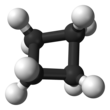Cyclobutane

| |||
| |||
| Names | |||
|---|---|---|---|
| Preferred IUPAC name
Cyclobutane | |||
| Other names
Ethene dimer
Biethylene Diethylene | |||
| Identifiers | |||
3D model (JSmol)
|
|||
| 1900183 | |||
| ChEBI | |||
| ChemSpider | |||
| EC Number |
| ||
| 81684 | |||
PubChem CID
|
|||
| UNII | |||
| UN number | 2601 | ||
| |||
| |||
| Properties | |||
| C4H8 | |||
| Molar mass | 56.107 g/mol | ||
| Appearance | Colorless gas | ||
| Density | 0.720 g/cm3 | ||
| Melting point | −91 °C (−132 °F; 182 K) | ||
| Boiling point | 12.5 °C (54.5 °F; 285.6 K) | ||
| Hazards | |||
| GHS labelling: | |||
 
| |||
| Danger | |||
| H220, H280 | |||
| P210, P377, P381, P403, P410+P403 | |||
| NFPA 704 (fire diamond) | <imagemap>
File:NFPA 704.svg|80px|alt=NFPA 704 four-colored diamond poly 150 150 300 300 150 450 0 300 Health 1: Exposure would cause irritation but only minor residual injury. E.g. turpentine poly 300 0 450 150 300 300 150 150 Flammability 4: Will rapidly or completely vaporize at normal atmospheric pressure and temperature, or is readily dispersed in air and will burn readily. Flash point below 23 °C (73 °F). E.g. propane poly 450 150 600 300 450 450 300 300 Instability 0: Normally stable, even under fire exposure conditions, and is not reactive with water. E.g. liquid nitrogen poly 300 300 450 450 300 600 150 450 Special hazards (white): no code desc none </imagemap> | ||
| Related compounds | |||
Related alkane
|
Butane | ||
Related compounds
|
Cyclobutene; Cyclobutadiene; Cyclopropane; Cyclopentane | ||
Except where otherwise noted, data are given for materials in their standard state (at 25 °C [77 °F], 100 kPa).
| |||
Cyclobutane is a cycloalkane and organic compound with the formula (CH2)4. Cyclobutane is a colourless gas and is commercially available as a liquefied gas. Derivatives of cyclobutane are called cyclobutanes. Cyclobutane itself is of no commercial or biological significance, but more complex derivatives are important in biology and biotechnology.[1]
Structure
The bond angles between carbon atoms are significantly strained and as such have lower bond energies than related linear or unstrained hydrocarbons, e.g. butane or cyclohexane. As such, cyclobutane is unstable above about 500 °C.
The four carbon atoms in cyclobutane are not coplanar; instead, the ring typically adopts a folded or "puckered" conformation.[2] This implies that the C-C-C angle is less than 90°. One of the carbon atoms makes a 25° angle with the plane formed by the other three carbons. In this way, some of the eclipsing interactions are reduced. The conformation is also known as a "butterfly". Equivalent puckered conformations interconvert:
Cyclobutanes in biology and biotechnology
Despite the inherent strain, the cyclobutane motif is indeed found in nature. One example is pentacycloanammoxic acid,[3] which is a ladderane composed of 5 fused cyclobutane units. The estimated strain in this compound is 3 times that of cyclobutane. The compound is found in bacteria performing the anammox process where it forms part of a tight and very dense membrane believed to protect the organism from toxic hydroxylamine and hydrazine involved in the production of nitrogen and water from nitrite ions and ammonia.[4] Some related fenestranes are also found in nature.[citation needed]
Cyclobutane photo dimers (CPD) are formed by photochemical reactions that result in the coupling of the C=C double bonds of pyrimidines.[5][6][7] Thymine dimers (T-T dimers) formed in between two thymines are the most abundant of the CPDs. CPDs are readily repaired by nucleotide excision repair enzymes. In most organisms, they can also be repaired by photolyases, a light-dependent family of enzymes. Xeroderma pigmentosum is a genetic disease where this damage can not be repaired, resulting in skin discolouration and tumours induced by exposure to UV light.
Carboplatin is a popular anticancer drug that is derived from cyclobutane-1,1-dicarboxylic acid.
Preparation
Many methods exist for the preparation of cyclobutanes. Alkenes dimerize upon irradiation with UV-light. 1,4-Dihalobutanes convert to cyclobutanes upon dehalogenation with reducing metals.
Cyclobutane was first synthesized in 1907 by James Bruce and Richard Willstätter by hydrogenating cyclobutene in the presence of nickel.[8]
See also
References
- ^ Lua error in Module:Citation/CS1/Configuration at line 2083: attempt to index a boolean value.
- ^ Lua error in Module:Citation/CS1/Configuration at line 2083: attempt to index a boolean value.
- ^ Lua error in Module:Citation/CS1/Configuration at line 2083: attempt to index a boolean value.
- ^ Lua error in Module:Citation/CS1/Configuration at line 2083: attempt to index a boolean value.Authors state that mode of biosynthesis is quite mysterious
- ^ Lua error in Module:Citation/CS1/Configuration at line 2083: attempt to index a boolean value.
- ^ Lua error in Module:Citation/CS1/Configuration at line 2083: attempt to index a boolean value.
- ^ Lua error in Module:Citation/CS1/Configuration at line 2083: attempt to index a boolean value.
- ^ Lua error in Module:Citation/CS1/Configuration at line 2083: attempt to index a boolean value.
External links
- Datasheet Link



